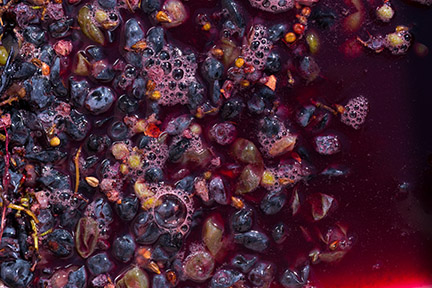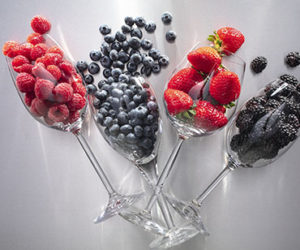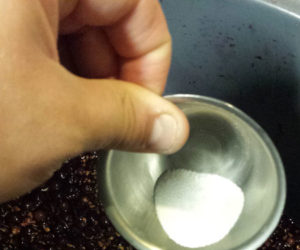Of course wine has alcohol in it — that much is given. Most of us also know that yeast is the producer of our alcohol. And the conditions that we provide for our yeast friends will play a large role to the extent of what alcohols are created. Most of us are familiar with ethanol, the primary alcohol found in wine and the substance that gives us a buzz. Today we’ll take a spin through some of the various alcohols we may encounter in our wine and ways we can control for them.
Ethanol
Often comprising somewhere between 10–15% of wine by volume, ethanol (or ethyl alcohol) is by far the most abundant alcohol found in our wines. Through the process of fermentation, yeast produces it to gain a competitive advantage over other microorganisms since ethanol is toxic. Different organisms have different tolerances, including yeast. For example, wine yeast generally has a stronger tolerance for ethanol than beer yeast. We humans have enzymes, found mainly in our liver, that process ethanol breaking it down into simpler compounds that can be flushed from our system through our kidneys. This process allows us to consume ethanol at fairly high levels compared to many other animals, but as we well know, it can come at a health cost if we abuse it.

Ethanol levels are typically determined by winemakers by the level of sugar in the initial grape juice, but there are many factors to consider that will determine just how much is in solution of the finished wine. Where the grapes were grown, the type of grapes, and when they were harvested are the primary factors that determine initial Brix levels that frequently will control final alcohol levels. But there are several nuances that can shift that dynamic, and that is especially true when we talk about wines that are made from something other than grapes. Yeast selection, chaptalization (adding sugar to boost ethanol levels), diluting the juice, and fortification of the wine are three ways that winemakers can sway the ethanol levels one way or the other.
Methanol
If you are familiar with the distillation process, or chemistry in general, then you’re probably familiar with methanol (or methyl alcohol). This is a highly toxic alcohol to humans and has been linked to blindness and even death in higher concentrations. Methanol is one of the main reasons distillers will dump the first runnings (called foreshots) that are driven out during the distillation process.
The good news for winemakers is that methanol is not really a concern in wine. One of the main pathways for yeast to produce methanol is through pectins; something found in fruit, but to extremely low levels of methanol that are nowhere near levels of concern. Distillers, on the other hand, need to be more careful of methanol. This alcohol is one of the main reasons that home distillation is illegal in most countries in the world.
Higher (Fusel) Alcohols
A lot of winemakers have heard about fusel or higher alcohols but they’re often not well understood. First off, they are found in grapes at low levels, but mostly are a product of the fermentation process. When found in higher concentrations, their characteristics are noted as a flaw (fusel translates to “bad liquor” in German). If your wine smells like kerosene or nail polish remover (besides maybe some petrol character from Riesling), you created too much fusel alcohols. When fusels are noted the yeast or fermentation conditions will be considered the root cause. Fusels are also commonly cited as a contributor to hangovers, but this is still a matter up for debate.
But all things fusels aren’t inherently bad, in fact a little fusels may be a good thing and even a happy, healthy fermentation will produce some.
Fusels are simply any alcohol compound that has more than two carbon atoms. But all things fusels aren’t inherently bad, in fact a little fusels may be a good thing and even a happy, healthy fermentation will produce some. Fusels are known for the warming sensation on the palate found in many wines. Fusels can exhibit characteristics ranging from ripe fruit to floral. At moderate levels these can work to build character, along with esters, in many fruit-forward wines.
When it comes to controlling fusel alcohol production, most winemakers look at the fermentation temperature. One of the most important things to note is that the pathway to fusel alcohol production is most active early in fermentation, during yeast growth. So if you have warm grapes or juice, be sure to get it down to within the preferred fermentation range within 12 hours or less after yeast pitch. After that period fusel production can begin in earnest. Don’t let your fermentation temperature rise above the recommended temperature range, often 65 °F (18 °C) for whites and rosés and 86 °F (30 °F) for reds. But be sure to follow the yeast manufacturer’s recommendations since each strain is unique.
There are also several lesser-known reasons for higher fusel production. Yeast selection is one of the biggest. As noted earlier, different yeast produce varying levels of fusels. Excessive use of yeast nutrients, nitrogen in particular, is also tied to higher production of fusels. So be sure to keep your YAN (yeast assimilable nitrogen) to recommended dosages. The presence of gross lees has been linked to higher levels of fusels as well. So for white wine fermentations, it’s best to let the lees settle for ~24 hours after crush and rack the juice off them before commencing fermentation. Finally, if the room you’re storing your active fermenter in is at 85 °F (18 °C), note that the temperature inside the fermentation is going to be several degrees warmer. My rule of thumb is to expect temperature in an active fermenter to be about 5 °F (2.5 °C) warmer than ambient air temperature in (this can get even warmer in larger fermentations). For a more in-depth look at higher alcohols, check out: https://winemakermag.com/technique/higher-alcohol-off-odors-in-wine







